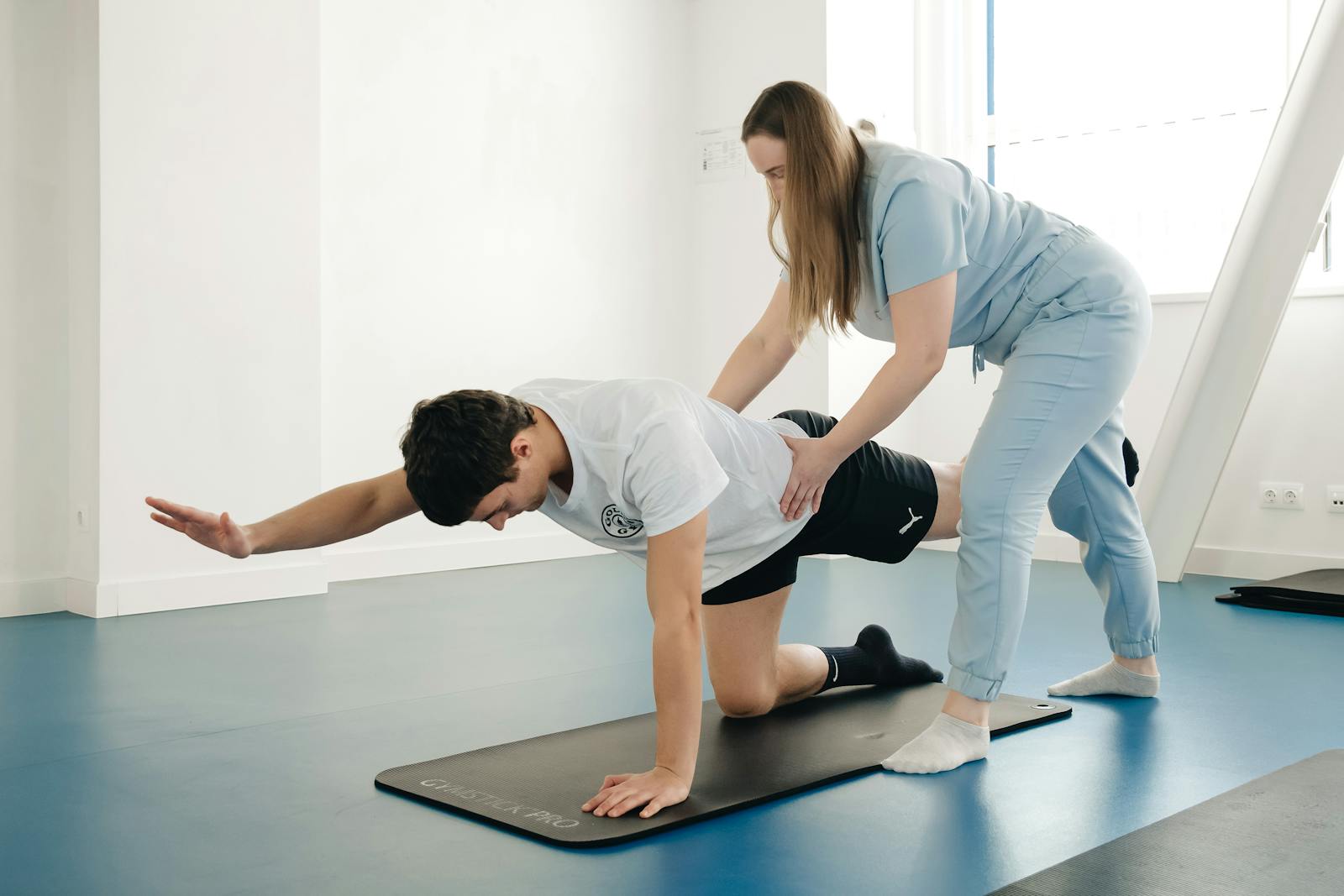Resuming exercise post-orthopedic surgery should be gradual and supervised. Start with low-impact activities and increase intensity over time. Physiotherapy plays an essential role in managing pain and guiding recovery. Maintain hydration and proper nutrition for body healing. Posture and core stability exercises prevent further injuries, while setting realistic goals keep you motivated in the process. Mental health is equally important and should not be overlooked. Finally, celebrate your progress to maintain high spirits during recovery. Your journey back to physical activity can be smooth with these tips and further exploring these aspects will enhance your understanding and process.
Understanding Your Surgery
To effectively navigate the journey of returning to exercise after an orthopedic surgery, it is fundamental to first understand the nature and impact of your specific surgical procedure. This involves acknowledging the intricacies of the operation, potential surgery complications, and the importance of thorough surgery preparation.
An orthopedic surgery, whether it be a joint replacement or a simple arthroscopy, can have a profound influence on your physical capabilities. The complexity and extent of your surgery can determine the severity of post-operative pain, swelling, and limitations in mobility, which can impact your return to physical activity.
Surgery complications, such as infection, blood clots, or issues with anesthesia, can also prolong your recovery. To mitigate these risks, a thorough pre-surgery preparation is essential. This includes maintaining a healthy lifestyle prior to surgery, following your surgeon’s instructions regarding medications, and understanding the expected post-surgery recovery timeline.
Importance of Post-Surgery Rest
In the journey of recovery after orthopedic surgery, a critical aspect often overlooked is the significance of post-surgery rest. Adequate rest plays a crucial role in facilitating the body’s healing process and ensuring excellent recovery outcomes. To highlight its importance, we will examine the understanding of healing timeframes and the necessity of rest following an orthopedic procedure.
Understanding Healing Timeframes
Frequently overlooked, yet immensely critical to the recovery process, is the understanding of healing timeframes following orthopedic surgery. These timeframes, grounded in medical science, are essential in shaping post-surgery mobility and surgical wound care. Every surgical procedure has its unique healing timeline, which dictates when and how an individual should start moving, to prevent complications such as blood clots or muscle atrophy. Additionally, proper wound care is pivotal during this period to avoid infections and facilitate the healing process. Understanding these timeframes enables patients to set realistic expectations, aiding in reducing anxiety and stress related to recovery. Ignoring these timelines or rushing recovery can lead to setbacks, further prolonging the healing process.
Necessity of Adequate Rest
While respecting the established healing timelines is of utmost importance, equally significant is the role of ample rest following an orthopedic surgery. The significance of adequate rest, in this particular situation, cannot be overstated. Rest facilitates the body’s natural healing process, assisting tissues to repair and rebuild themselves. During rest, the body allocates more resources towards healing, making recovery more effective.
Moreover, Recovery Sleep, a deeper and more rejuvenating form of rest, is essential in post-surgery healing. Hormones released during sleep promote tissue growth and repair, reducing inflammation and enhancing immune defense. It is vital to allow your body adequate rest and quality sleep, to ensure successful recovery and a successful return to physical activity post-orthopedic surgery.
Setting Realistic Exercise Goals
Establishing attainable and practical exercise goals is a critical step towards a successful recovery post-orthopedic surgery. This process involves careful planning, regular Goal Measurement, and potential Exercise Modification to accommodate one’s physical capabilities and limitations after the surgery.
Here are four key strategies to help you set realistic exercise goals:
- Start Small: Initiate with less strenuous exercises and gradually increase the intensity as your body adapts. Aim for consistency rather than intensity at the initial stages.
- Set Short-Term Goals: Short-term goals are more manageable and provide a sense of achievement, thereby establishing a positive reinforcement loop.
- Include Exercise Modification: Modify your exercise routine based on your body’s response. This might mean reducing the intensity or duration of certain workouts if you experience discomfort or pain.
- Track Progress Regularly: Invest in a good tracking system for Goal Measurement. Regular tracking not only keeps you motivated but also helps identify any necessary adjustments.
Gradual Return to Physical Activity
A systematic and phased approach to resuming physical activity post-orthopedic surgery is often suggested by healthcare professionals to ensure a safe and effective recovery. The gradual return to physical activity is designed to prevent any potential re-injury, while also allowing the body to adjust and regain strength progressively.
Post-surgery mobility can be severely limited, initially and careful management is essential to restore function. This involves starting with gentle, non-weight bearing exercises, like moving your limbs in bed, to slowly regain muscle strength and joint flexibility. This phase should not be rushed as it forms the foundation for more complex movements in subsequent stages.
Pain management techniques are also an important part of a balanced recovery plan. They can include a combination of medication, rest, ice, compression, and elevation (RICE), along with controlled physical activity. It is critical to listen to your body during this period. If any activity causes persistent pain, it should be discontinued and a healthcare professional consulted.
A gradual return to physical activity, hence, can lead to a smooth shift back to a regular exercise routine and help achieve best post-surgery mobility, provided it is managed effectively and carefully.
The Role of Physiotherapy
In the journey of post-orthopedic surgery recovery, physiotherapy plays an integral role, offering a structured approach to restoring optimum levels of mobility and function. Physiotherapy combines specialized exercises, manual therapy, and equipment adaptation to enhance recovery and improve overall quality of life.
- Physiotherapist Selection: Selecting a knowledgeable and experienced physiotherapist is essential for a successful recovery. A qualified practitioner can devise an individualized treatment plan, keeping in mind the specific needs and limitations of the patient.
- Pain Management: Physiotherapy employs techniques that help manage post-surgical pain effectively, thereby speeding up the healing process.
- Equipment Adaptation: This involves utilizing adaptive equipment such as crutches, braces, or wheelchairs. Physiotherapists guide patients on how to use these tools efficiently, maximizing independence and safety.
- Education and Support: Physiotherapists provide crucial education regarding the recovery process, including advice on activity modification, correct posture, and the importance of rest periods.
To summarize, physiotherapy is a critical component of the recovery journey following orthopedic surgery. The right physiotherapist and the proper use of adaptive equipment can significantly enhance the healing process, leading to a successful return to physical activity.
Strengthening Exercises for Recovery
Following the effective use of physiotherapy, the incorporation of specific strengthening exercises becomes a significant part of the recovery process after orthopedic surgery. These exercises, tailored to the patient’s individual needs and surgical outcomes, aim to restore strength, mobility, and function to the affected areas.
Strengthening exercises focus not only on the injured area but also the supporting muscles to improve overall structural integrity. The principle of ‘posture correction’ is integral to this process. By focusing on correct alignment and movement patterns, these exercises help minimize undue strain and promote efficient muscle function. This balanced muscular activity aids in maintaining proper posture, thereby reducing the risk of further injury.
Incorporating exercises that target core stability can also enhance posture, offering additional support to the spine and limbs during movement. These activities, combined with targeted strength training, foster ‘injury prevention’ by improving resilience and endurance within the musculoskeletal system.
Ultimately, the goal is to safely return to pre-surgery levels of physical activity. It’s essential to progress these strengthening exercises under the guidance of a trained physiotherapist or orthopedic specialist, ensuring an ideal recovery trajectory while minimizing the risk of re-injury.
Staying Hydrated and Nutrition Tips
Proper hydration and nutrition play pivotal roles in the post-operative recovery process, particularly when resuming exercise after orthopedic surgery. Understanding the importance of hydration, meeting post-surgery nutritional needs and balancing your diet can greatly expedite the healing process. This section will provide valuable insights into these essentials, aiding in a smoother and more effective recovery.
Importance of Hydration
Sustaining ideal hydration levels is an essential aspect of the recovery process post orthopedic surgery, with a direct impact on the body’s healing capabilities and overall health. Appropriate fluid intake is important, and understanding common hydration myths can help maintain a balanced regimen.
- Fluid Intake: Aim for at least 8 glasses of water daily. Rehydration salts can also be beneficial to replenish electrolytes.
- Hydration Myths: All liquids hydrate equally; this is a myth. Beverages with high sugar or alcohol content can lead to dehydration.
- Signs of Dehydration: Watch for symptoms like dry mouth, fatigue, and dizziness.
- Hydration and Healing: Hydration aids in flushing toxins, delivering nutrients to cells, and maintaining tissue elasticity, accelerating the healing process.
Post-Surgery Nutritional Needs
Understanding the post-surgery nutritional needs is a crucial aspect of recovery, encompassing both adequate hydration and a balanced, nutrient-rich diet. It is crucial to contemplate supplement intake to make certain your body receives all the necessary nutrients for muscle regeneration. Supplements such as protein, vitamin C, and zinc can aid in the healing process, promoting tissue repair and strengthening the immune system.
Hydration is also a vital component; maintaining an ideal fluid balance helps to replenish lost body fluids during surgery and aids in digestion and nutrient absorption. Be mindful of your body’s signals for thirst and ensure a consistent fluid intake. Remember, your nutritional needs post-surgery are unique and should be tailored to your individual recovery process.
Balancing Diet for Recovery
While recuperating from orthopedic surgery, a well-rounded diet that prioritizes hydration and key nutrients is crucial in facilitating a smooth and successful healing process.
- Hydration: Maintain sufficient fluid intake post-surgery to assist in nutrient transport and tissue repair.
- Caloric Intake: Monitor your caloric intake to guarantee it aligns with your reduced physical activity levels and prevents weight gain.
- Supplement Usage: Include doctor-recommended supplements to bridge nutritional gaps, accelerate the healing process, and improve overall health.
- Nutrient-Dense Foods: Concentrate on protein-rich foods, fruits, vegetables, and whole grains to provide essential vitamins and minerals for recovery.
Adopting these dietary strategies, alongside your prescribed physical therapy regimen, can significantly hasten your recovery and return to normal physical activity post-surgery.
Listening to Your Body
In the process of resuming physical activity after orthopedic surgery, it is critical to pay close attention to the signals your body is sending you. This entails developing body awareness and carefully monitoring for pain recognition.
Body awareness involves being attuned to your physical state, noting changes in strength, balance, and overall mobility. It’s important to understand your body’s limitations and respect them. Pushing your body beyond its current capabilities can lead to re-injury or delay in the healing process.
Pain recognition, on the other hand, involves distinguishing between discomfort from engaging unused muscles and the pain that signifies harm. Not all discomfort is detrimental; some may be a natural response to resuming activity. However, sharp, persistent, or increasing pain may indicate strain or damage and should not be ignored.
Listening to your body also means recognizing signs of fatigue. If you’re consistently feeling exhausted after your exercises, it might indicate that your body needs more time to recover.
Mental Health and Exercise
The intersection between mental health and exercise is especially relevant in the context of post-operative recovery. Overcoming the stress associated with surgery can be a challenging process, necessitating a holistic focus on both physical and mental health. The mood-enhancing benefits of exercise, especially in the post-surgery phase, can play a pivotal role in this regard, assisting in reducing anxiety levels and fostering a positive mental outlook.
Overcoming Post-Surgery Stress
Handling the mental strain that often comes with recovery from orthopedic surgery can prove challenging, yet incorporating regular exercise into your post-surgery routine can greatly alleviate stress and enhance overall mental health. Building emotional resilience and using stress management techniques can be instrumental in overcoming post-surgery stress.
Here are four key steps to contemplate:
- Develop a Routine: Establishing a consistent exercise routine can provide a sense of control during the recovery period.
- Practice Mindfulness: Incorporating mindfulness exercises can promote relaxation and stress relief.
- Build Emotional Resilience: Fostering emotional resilience can help you adapt to the changes and challenges post-surgery.
- Employ Stress Management Techniques: Techniques like deep breathing, progressive muscle relaxation, and visualization can be effective tools in managing post-surgery stress.
Exercise and Mood Enhancement
As you regain physical strength and gradually return to exercise following orthopedic surgery, you will likely experience a significant enhancement in mood and general mental health. This boost is often referred to as exercise-induced happiness. This positive psychological response is triggered by the release of endorphins, serotonin, and other mood-enhancing neurochemicals during physical activity. Utilizing mood metrics tracking can provide a tangible measure of this improvement, allowing you to observe the correlation between exercise and your mental well-being. Regular exercise post-surgery can also aid in alleviating symptoms of anxiety and depression, contributing to a more robust recovery. Hence, a gradual return to physical activity is not just beneficial for your physical rehabilitation, but also your mental health.
Avoiding Potential Injuries
In the domain of orthopedic post-surgery recovery, vigilance in avoiding potential injuries is crucial to achieving peak rehabilitation outcomes. Adhering to injury prevention techniques and making effective use of adaptive equipment can greatly reduce the risk of setbacks during this critical period.
- Gradual Progression: Start slowly and gradually increase your activity levels. This can help avoid strain and stress on the healing area.
- Proper Form: Make sure that you are using the correct form and technique during exercises to avoid unnecessary strain or injury.
- Use of Adaptive Equipment: Utilize adaptive equipment as recommended by your therapist. This can aid in the safe execution of exercises and everyday activities, reducing the risk of injury.
- Consistent monitoring: Regularly review your progress with your physical therapist. They can adjust your exercise regime as needed to prevent injury while ensuring the best recovery.
Celebrating Milestones and Progress
Recognizing and celebrating each milestone during the post-surgery recovery period serves as a powerful motivator, fostering both physical and psychological progress toward regaining peak functionality. Emphasizing the importance of progress celebration methods, it is critical to understand that these don’t have to be grand gestures. Simple, meaningful acknowledgments of each achieved goal can greatly boost morale and promote adherence to the recovery regimen.
Milestone motivation techniques can range from verbal affirmations to visual representations of progress, such as tracking charts or graphs. Regularly reviewing these visual aids can provide a tangible sense of accomplishment and progress, reinforcing the patient’s commitment to the recovery process.
Incorporating rewards into the recovery plan is another effective strategy. These rewards need not be extravagant. Something as simple as a favorite meal, a new book, or extra leisure time can serve as strong incentives for reaching specific milestones.
Frequently Asked Questions
What Are Some Common Misconceptions About Exercising After Orthopedic Surgery?
Common misconceptions, or ‘Post Surgery Myths’, about exercising after orthopedic surgery include assuming immediate total rest is best, or that pain indicates damage. These ‘Exercise Misunderstandings’ often hinder peak recovery and rehabilitation.
How Can I Balance My Medication Intake With My Exercise Routine After Surgery?
Balancing medication intake with your exercise routine post-surgery involves understanding medication timing and the effects of exercise on your body. Consult your doctor for personalized advice, ensuring neither interferes with the other’s effectiveness.
How Can I Manage Any Feelings of Discomfort or Pain During My Exercise Routines?
Managing discomfort during exercise routines post-surgery involves utilizing pain management techniques, such as mindful breathing or medication. Additionally, personalized exercise regimens, designed by your healthcare provider, make sure activities are safe and adjusted to your pain levels.
Can I Still Participate in High-Impact Sports After Recovery From Orthopedic Surgery?
Yes, participation in high-impact sports post-orthopedic surgery is often possible with proper rehabilitation. However, sporting modifications and injury prevention strategies are vital to reduce risks and promote safe, effective physical activity. Always consult your surgeon or physiotherapist.
What Are Some Ways to Maintain Motivation for Consistent Exercise During the Recovery Process?
Maintaining motivation during recovery can be achieved through setting achievable goals, recognizing exercise rewards such as improved strength and flexibility, and acknowledging mental health benefits like stress reduction and improved mood. Regular progress tracking can also boost motivation.



